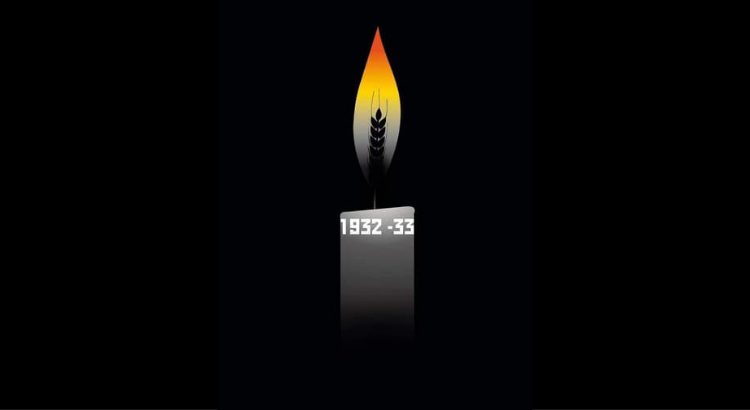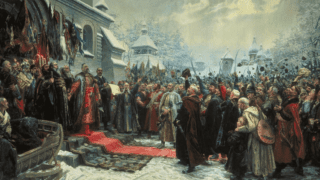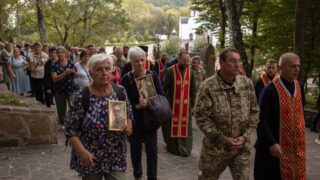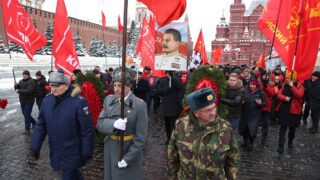
What to read about the Holodomor at Euromaidan Press
This year, Holodomor Commemoration Day in Ukraine falls on November 23. Each year, on the last Saturday of the month, Ukrainians commemorate the millions of victims of the artificial man-made famine unleashed in 1932-33 by communist dictator Joseph Stalin. From witness testimonies to calculating the death rates, Euromaidan Press has covered the Holodomor extensively. In our library, everyone will find something new to discover about one of the greatest acts of genocide of the XX century.
General information
At least four million people starved to death in Ukraine during the Holodomor. At the height of the Holodomor, 28,000 people were dying per day. This number does not include the ethnic Ukrainians outside the Ukrainians SSR who died, the half million people deported from Ukraine during collectivization or the thousands of religious, cultural and political leaders who were destroyed. The USSR attempted to cover up the Holodomor, and Russia continues to deny or diminish it to the very day: Holodomor: Stalin’s genocidal famine of 1932-1933 | Infographic
Was it a genocide?
Was the Holodomor caused merely by the radical policy of collectivization and industrialization amid the sharp decline of agricultural workers and falling motivation to work, because of the loss of private ownership? Or was the famine created to destroy several ethnicities, in particular, the Ukrainians and Kazakhs? In the second case, it can be classified as genocide. The debate on these questions is ongoing, and Holodomor so far has been recognized as genocide by 18 countries so far. Here we dissect the arguments of the nay-sayers: Was Holodomor a genocide? Examining the arguments
Does the man-made Great Famine of 1932–33 in Kremlin-ruled Ukraine fit the criteria of genocide? James Oliver argues that it definitely does in his review of the new book Red Famine: Stalin’s War on Ukraine by Pulitzer Prize-winner Anne Applebaum: Why the Holodomor is genocide under UN convention: On Anne Applebaum’s Red Famine
Professor Philippe de Lara gave a lecture about the unique nature of the two genocides: the Holocaust as a crime against the Jewish people and the Holodomor as a crime against the Ukrainian people. The Kremlin intended Holodomor to become Ukraine’s Holocaust, de Lara believes: Why compare the Holodomor and the Holocaust
Also:
Holodomor denial
Soviet propaganda continues to shape the beliefs of Russians about the Russian and Soviet past and continues to infect public consciousness in the West. The Kremlin’s ongoing denial that Ukrainians were subject to a genocidal famine in 1932-33 under Stalin is a clear example. Russian historiography on the subject contorts the truth to promote the goals of the state, fueled by the legacy of the USSR and its state-decreed “truth.” Unlike post-WWII Germany which went through a de-nazification program, Russia has not gone through a de-Sovietization process since the collapse of the USSR. In fact, under Russian President Putin, who began his career in the murky world of the Soviet KGB, Russian historians continue to recycle and reinforce Soviet-era myths: On Holodomor denial, and fisking a denialist Russian professor of History
What is slowing down the recognition of the mass annihilation by famine of Ukrainians by the Stalinist regime as genocide? Why is Russia so strongly opposed to this process? How did Jews and Armenians gain recognition of the genocide against their people? How does this affect geopolitics? Holodomor, Genocide & Russia: the great Ukrainian challenge
Also:
A famine similar to the Holodomor took place in Kazakhstan
As a result of a new film called “Zulmat,” the Kazakh word for Holomodor or terror famine, Kazkhs increasingly recognize that the famine was not an accident of nature but rather the result of Moscow’s policies and thus constitute an act of genocide, a view that necessarily changes their view of Russia: New film shows Kazakhs they suffered a Holodomor too, infuriating Moscow
There is a crime of Stalin against humanity that goes relatively unnoticed – the artificial famine against Kazakhs, or the Goloshchekin genocide: Stalin’s Holodomor in Kazakhstan, or a very brief guide to “The Goloshchekin genocide”
Death tolls: estimates and controversy
The debate on how many Ukrainians died as a result of the Holodomor famine of 1932-1933 rages on. The Ukrainian website likbez.org.ua, a joint project of Ukrainian professional historians as well as journalists to popularize Ukrainian history and debunk historical myths and propaganda, gives a short review on why the number of losses from the Holodomor one can encounter is so diverse, of which we offer an adapted translation to English: So how many Ukrainians died in the Holodomor?
The scientifically sound estimate of the number of Ukrainians who starved to death in Stalin’s Holodomor famine is roughly 4 million. Yet, many scholars attempt to impose unrealistically inflated numbers — up to 15 million. This does no justice either to the victims, or to the status of the recognition of the artificial famine as a genocide of Ukrainians: More is not better. The deleterious effects of artificially inflated Holodomor death tolls
Holodomor in the context of communism & collectivization
Stalin did this because he feared Ukrainians and their movement towards wider autonomy. Around 5,000 peasant revolts against the Soviet policy of collectivization with more than 1 million involved took place in Ukraine just before the Holodomor: Holodomor: Stalin’s punishment for 5,000 peasant revolts
Also:
Photos
Many photos found online purporting to show Holodomor victims are actually from other episodes of starvation in the Soviet Union. There actually are very few photographs of the Holodomor, the genocidal famine that carried away the lives of roughly 4 million Ukrainians in the winter of 1932-1933. The reason for this is that in those years Soviet authorities created a virtual Soviet reality for the foreign world that included concealment and denial of the Holodomor.
They were careful to manage the image of the USSR abroad after the 1921-23 famine that was a PR catastrophe for the Bolshevik government. Then, the burgeoning Soviet state accepted the aid of foreign humanitarian agencies in return for their freedom to operate, as a result of which the world saw the full extent of the human misery on Soviet soil. Censorship and broad restrictions made documentation and reporting of facts challenging; nevertheless, some photos did leak out from behind the Soviet border. The most famous ones were made by the Austrian engineer Alexander Wienerberger.
Witness testimonies
As a partner of the Holodomor Museum in Kyiv, Euromaidan Press has published 10 testimonies of living witnesses who survived the Holodomor:
- Starved mother lay dead while her baby sucked on empty breast | Voices of Holodomor witnesses
- My granny stole pig food for us grandchildren but died of starvation herself | Voices of Holodomor witnesses
- Half our village died of starvation, mostly the elderly | Voices of Holodomor witnesses
- My neighbor buried her three children | Voices of Holodomor witnesses
- Every day two or three people starved to death in our village | Voices of Holodomor witnesses
- My village once saw twelve people die of hunger in one day | Voices of Holodomor witnesses
- My family survived Holodomor by eating waste left from sugar production | Voices of witnesses
- My neighbors escaped starvation by eating grain stored by field mice | Voices of Holodomor witnesses
- How my father saved his co-villagers from starvation during the Holodomor | Voices of witnesses
- Surviving in the “collective farm paradise”: voices of living Holodomor witnesses
Also:
Experience
MOBILE APP
Many streets and buildings of the Ukrainian capital Kyiv are closely associated with the genocide — and with particular stories of people surviving or witnessing the famine of 1932-1933. If Kyiv could talk… That is the main idea behind a new phone app telling the story of Holodomor: Holodomor survivor stories come to life in mobile app for tourists
ONLINE “RESTAURANT”
Students from the Ukrainian Leadership Academy have launched an online “restaurant” featuring “recipes” thanks to which many Ukrainians survived the Holodomor: Bread from tree bark and straw: students launch online “restaurant” with Holodomor “recipes”
FILM: HUNGER FOR TRUTH
The Canadian journalist who was the first to write about the 1932 genocidal famine in Ukraine — Rhea Clyman — died in New York, in 1981, forgotten. Only recently has her story come to light in the 2018 documentary film, The Hunger for Truth: The Rhea Clyman Story, co-produced by American filmmaker Andrew Tkach and Kyiv-based Babylon 13 (find options to watch inside the link) — The Hunger for Truth: Documentary about Canadian journalist who was first to report about Holodomor. It was recently updated with contemporary scenes about the Ukrainian struggle for independence.
FILM: MR. JONES
Mr. Jones is a biographical thriller created by Polish film director Agnieszka Holland. The movie was nominated for the Golden Bear at the 69th Berlin International Film Festival.
This film depicts the story of Gareth Jones, an English journalist famous for his interview with Adolf Hitler. In 1933, Mr. Jones plans to visit Moscow for an interview with Stalin to learn about the Soviet economic plans. Instead, he discovers the grim reality withheld by the USSR from the rest of the world — the Holodomor. Watch the movie in English on Amazon Prime.
FILM: BITTER HARVEST
The history behind “Bitter Harvest,” dramatic movie about the Holodomor. The first historical drama “Bitter Harvest” was written by Richard Bachynsky-Hoover and George Mendeluk
FILM: GENOCIDE REVEALED
The documentary (75mins, English, Ukrainian, French) “Genocide Revealed” by Canadian filmmaker Yurij Luhovy, exposes Moscow’s policy of genocide against the Ukrainian nation. The film focuses on the man-made famine in Soviet Ukraine engineered by Stalin’s regime and the accompanied decimation of the national elite and the destruction of Ukraine’s historical past. It reveals one of the greatest human tragedies of the 20th century. Millions perished. “Genocide Revealed” is based on testimonies of survivors, commentaries by historians, declassified Soviet archival documents, and rare historical footage: Documentary Genocide Revealed launches new web site





















